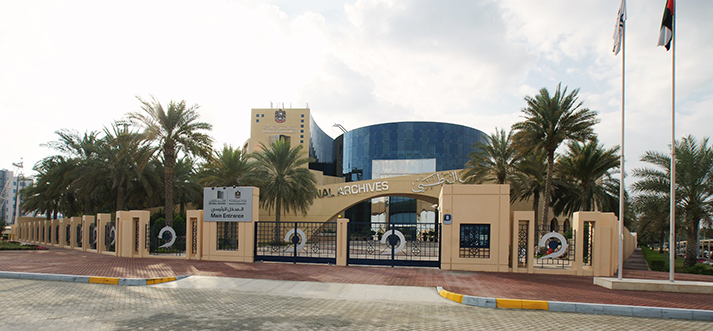
The National Archives issued the 14th issue of the refereed academic journal “Liwa”
The National Archives issued the 14th issue of the refereed academic journal "Liwa".
The National Archives issued the 14th issue of the refereed academic journal "Liwa" which is issued bi-annually in Arabic and English, and is dedicated to the study of the history, archeology and heritage of the United Arab Emirates and the Arabian Gulf Region.
The new edition of "Liwa" contained five research papers. Ahmed Mubarak Salem wrote a paper entitled: "Shaikh Isa Bin Ali and his role in the political and economic reform", Shamsa Hamad Al Dhaheri wrote a paper entitled: "A study in the social history of the Muwaiji Oasis in the mid-twentieth century”. Peter Wemsley wrote on " Tarif and Murban No.1, 1954 ", while Dr. Hayat Bint Munawer Bin Farhan Al-Rashidi wrote a paper entitled “The Profession of Providing Zamzam water to Pilgrims in the third Saudi era, The Unified Zamazimah Office as a Model”. Imad bin Jassim al-Bahrani reviwed a book entitled: Oman’s Foreign Trade during the Reign of Sultan Faisal Bin Turki Al-Busaidi, 1305 ".
The first research focuses on the late Sheikh Isa Bin Ali Al Khalifa’s era and the stability and security that prevailed then together with the transformations it witnessed. The researcher was keen to clarify the facts and analyze events to set the record straight on the various aspects associated with the political and economic reform during Sheikh Isa Bin Ali's reign.
This research paper is divided into several chapters: the first of which deals with the life of Sheikh Isa Bin Ali, his birth and early life, his appointment as Ruler of Bahrain and his reign. It documents the history of Bahrain during his time in power. The second chapter deals with Shaikh Isa Bin Ali and his role in political reform, and manifestations of the state's democratic life, administrative organization, institution-building, and foreign policy, etc.
In the second paper entitled “A study in the Social History of the Muwaiji Oasis in the Mid-twentieth century”, Shamsa Hamad Al Dhaheri wrote about Al Muwaiji, the land in the far west of Al Ain Oasis and within its scope. It was considered the center of power in the Eastern Regions of the Emirate of Abu Dhabi. People settled there because of the abundance of its water and its picturesque nature. It flourished through various development projects when Al Ain witnessed local developments of great importance upon Sheikh Zayed Bin Sultan Al Nahyan's onset of political career in 1946 as the governor's representative in the Eastern Region, who took Al Muwaiji as his official capital.
The paper also dealt with people's settlement, agricultural activity, Al Muwaiji Falaj, the residential districts and residence of the ruling family, and Al Muwaiji Palace which is considered one of the most important palaces in Al Ain and a great historical masterpiece. The paper explores as well Al Muwaiji Mosque, and the Palaces of Sheikh Shakhbout Bin Sultan, Sheikha Latifa Bint Zayed the First, and Sheikh Mubarak Bin Mohammed, in addition to the palace of the spouses of Sheikh Hazza Bin Sultan, and the palace of Sheikha Salama Bint Butti, which was the first palace built for her in the Muwaiji oasis, near her family's palm tree farms.
The paper also sheds light on the palaces of Sheikh Khalid bin Sultan and Sheikha Mahra bint Khalid, and the shops of Muwaijei. It documents the development strategy in Muwaiji as it traces the main points of Sheikh Zayed Bin Sultan Al Nahyan's development strategy in this Oasis, and his projects there, such as: Sharia Court, Al Muwaiji School, and Al Muwaiji Hospital. The writer concluded her paper with footnotes, sources and references.
The third paper in “Liwa” Journal, entitled "Tarif and Murban No. (1), 1954" by Peter Wemsley, is about life in Tarif during the drilling of the Murban NO. 1 oil well.
In the fourth research entitled " The Profession of Providing Zamzam water to Pilgrims in the third Saudi era, The Unified Zamazimah Office as a Model”, Dr. Hayat Bint Munawer Bin Farhan Al-Rashidi examined the career of supplying pilgrims with water in the prosperous Saudi era. She illustrates the attention dedicated by the Ruler and other concerned parties to promote and support this mission; due to the importance of this profession (Sekaya) represented by Al Zamazimah office, and the great services it provides under the auspices of the Ruler and other officials. The study was divided as follows: study of the history of Al zamazimah, the profession of supplying water in the third Saudi era, and the Unified Zamazimah Office. It began with a brief history of supplying pilgrims with water.
The 14th issue of “Liwa” Journal presented a book review of: (Oman's Foreign Trade during the Reign of Sultan Faisal Bin Turki Al-Busaidi), which was originally a master thesis submitted to Sultan Qaboos University in 2006 by the researcher Ismail bin Ahmad Al-Zedjali. The importance of the book is derived from the fact that the era of Sultan Faisal Bin Turki Al Busaidi was one an important one as the country witnessed several political events, in respect of the internal Omani situation and the foreign relations with major powers, especially Britain and France. The book is divided into three chapters: political developments in Oman under Sultan Faisal Bin Turki and their impact on promoting foreign trade, arms trade in Oman, and International trade between Oman and the world during the reign of Sultan Faisal Bin Turki.
“Liwa” journal welcomes all serious academic research, conforming with publishing terms, and related to the history, heritage and archeology of the United Arab Emirates and the Gulf region in general.
